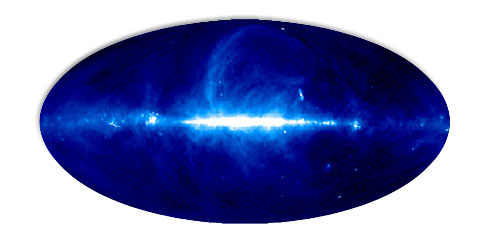 |
 |
Galactic Emission
Photons from the cosmic microwave background must traverse the Galaxy
before reaching Earth. Understanding Galactic radio emission is an important
part of the ARCADE scientific effort.

Diffuse Galactic emission at centimeter wavelengths
is dominated by three components,
as shown in the plot below:
synchrotron emission from cosmic-ray electrons (green),
electron-ion bremsstrahlung (free-free emission)
from diffuse ionized gas (yellow),
and thermal radiation from interstellar dust (blue).
A fourth emission component,
from small rapidly spinning dust grains (purple)
has also been proposed.

Despite surveys carried out over many years,
relatively little is known about the physical conditions
responsible for these diffuse emissions.
A limiting factor has been
the large (10%) calibration uncertainties in radio surveys
and the decade gap in frequency coverage
between ground-based radio surveys
and the millimeter-wave measurements
by the
COBE
and
WMAP
satellites.
By measuring both the spectrum and angular distribution
of diffuse microwave emission,
ARCADE will separate Galactic from cosmic emission
and provide answers to outstanding questions on
physical conditions in the interstellar medium (ISM),including:
What is the heating mechanism in the ISM?
Is the diffuse ionized gas heated by photoionization from the stellar disk,
supernova shocks, Galactic fountain flows, or decaying dark matter?
How are cosmic rays accelerated?
Is the energy spectrum of local cosmic-ray electrons
representative of the Galaxy as a whole?
What is the shape, constitution, and size distribution
of interstellar dust?
Is there a distinct "cold" component in the infrared cirrus?
Is spinning dust a significant component of Galactic emission?
Have we properly accounted for the combined microwave emission
from our galaxy?
ARCADE's observations will be particularly useful
for modeling synchrotron emission.
By providing absolute calibration for large regions of the sky,
tied to a common full-beam standard,
it will help disentangle microwave emission
at millimeter wavelengths
where multiple emission components
are present at roughly equal amplitude.
|
|


